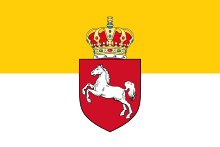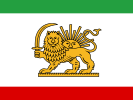Archduke Joseph Karl of Austria
Archduke Joseph Karl of Austria (German: (Erzherzog) Josef Karl (Ludwig) von Österreich, Hungarian: Habsburg–Toscanai József Károly (Lajos) főherceg; 2 March 1833 in Pressburg – 13 June 1905 in Fiume) was a member of the Habsburg-Lorraine dynasty. He was the second son of Archduke Joseph, Palatine of Hungary (7th son of Leopold II, Holy Roman Emperor) and Duchess Maria Dorothea of Württemberg.

Like many junior members of royal families, Archduke Joseph Karl entered the military. He became a Major General in the Austrian Army in 1860. During the Austro-Prussian War he commanded a Brigade in the North Army and had three horses shot under him at Königgrätz.[1] In 1867, he became Palatine of Hungary after the death of his childless half-brother Stephen, though the post by that time was symbolic only.
The archduke had an interest in Romani language and occasionally wrote on this topic to Albert Thomas Sinclair, an American lawyer who shared this interest. A biography of Sinclair notes that the archduke sent a copy of his work, "a large octavo volume handsomely bound It is a most important and valuable philological work comparing the gypsy words with Sanskrit, Hindustani Persian, etc".[2]
Marriage and issue
On 12 May 1864 in Coburg, Archduke Joseph married Princess Clotilde of Saxe-Coburg and Gotha (1846–1927), the elder daughter of Prince August of Saxe-Coburg and Gotha and Princess Clémentine of Orléans. They had seven children :
- Archduchess Elisabeth Klementine of Austria (18 March 1865 – 7 January 1866)
- Archduchess Maria Dorothea of Austria (14 June 1867 – 6 April 1932)
- Archduchess Margarethe Klementine of Austria (6 July 1870 – 2 May 1955)
- Archduke Joseph August of Austria (9 August 1872 – 6 July 1962)
- Archduke László of Austria (16 July 1875 – 6 September 1895)
- Archduchess Elisabeth Klothilde of Austria (9 March 1883 – 8 February 1958)
- Archduchess Klothilde of Austria (9 May 1884 – 14 December 1903)
Honours
He received the following orders and decorations:[3]

- Knight of the Golden Fleece, 1852[4]
- Grand Cross of St. Stephen, 1871[4]
- Military Merit Cross, in Diamonds
- Military Merit Medal on Red Ribbon

.svg.png)
.svg.png)
.svg.png)

- Knight of St. George, 1857
- Grand Cross of the Royal Guelphic Order, 1857
.svg.png)
.svg.png)
.svg.png)


.svg.png)


.svg.png)
.svg.png)


- Knight of St. Andrew
- Knight of St. Alexander Nevsky
- Knight of the White Eagle
- Knight of St. Anna, 1st Class
.svg.png)
.svg.png)
Ancestry
| Ancestors of Archduke Joseph Karl of Austria | |||||||||||||||||||||||||||||||||||||||||||||||||||||||||||||||||||||||||||||||||||||||||||||||||||||||||||||||||||||||||||||||||||||||||||||||||||||||||||||||||||||||||||||||||||||||||||||||||||||||||||||||||||||||||||||||||||||||||||||||||||||||||||||||||||||||||||||||||||||||||
|---|---|---|---|---|---|---|---|---|---|---|---|---|---|---|---|---|---|---|---|---|---|---|---|---|---|---|---|---|---|---|---|---|---|---|---|---|---|---|---|---|---|---|---|---|---|---|---|---|---|---|---|---|---|---|---|---|---|---|---|---|---|---|---|---|---|---|---|---|---|---|---|---|---|---|---|---|---|---|---|---|---|---|---|---|---|---|---|---|---|---|---|---|---|---|---|---|---|---|---|---|---|---|---|---|---|---|---|---|---|---|---|---|---|---|---|---|---|---|---|---|---|---|---|---|---|---|---|---|---|---|---|---|---|---|---|---|---|---|---|---|---|---|---|---|---|---|---|---|---|---|---|---|---|---|---|---|---|---|---|---|---|---|---|---|---|---|---|---|---|---|---|---|---|---|---|---|---|---|---|---|---|---|---|---|---|---|---|---|---|---|---|---|---|---|---|---|---|---|---|---|---|---|---|---|---|---|---|---|---|---|---|---|---|---|---|---|---|---|---|---|---|---|---|---|---|---|---|---|---|---|---|---|---|---|---|---|---|---|---|---|---|---|---|---|---|---|---|---|---|---|---|---|---|---|---|---|---|---|---|---|---|---|---|---|---|---|---|---|---|---|---|---|---|---|---|---|---|---|---|---|---|
| |||||||||||||||||||||||||||||||||||||||||||||||||||||||||||||||||||||||||||||||||||||||||||||||||||||||||||||||||||||||||||||||||||||||||||||||||||||||||||||||||||||||||||||||||||||||||||||||||||||||||||||||||||||||||||||||||||||||||||||||||||||||||||||||||||||||||||||||||||||||||
References
- Craig, Gordon A (2003). The Battle of Koniggratz: Prussia's Victory Over Austria, 1866. University of Pennsylvania Press. p. 133. ISBN 0812218442. Retrieved 16 July 2017.
- John Perkins and Cushing Winship, Historical Brighton, Vol. 2, pp. 46-7 (1902) https://books.google.com/books?id=CXkUAAAAYAAJ&dq=Thomas%20Tracy%2C%20ninth%20son%20of%20Sir%20Paul%20Tracy%2C%20...&pg=PA47#v=onepage&q=Thomas%20Tracy,%20ninth%20son%20of%20Sir%20Paul%20Tracy,%20...&f=false
- "Genealogie des Allerhöchsten Herrscherhauses", Hof- und Staatshandbuch der Österreichisch-Ungarischen Monarchie, 1904, p. 11, retrieved 23 July 2020
- "Ritter-Orden", Hof- und Staatshandbuch der Österreichisch-Ungarischen Monarchie, 1904, pp. 51, 54, retrieved 24 July 2020
- Hof- und Staatshandbuch des Großherzogtums Oldenburg0: 1879. Schulze. 1879. p. 32.
- Staatshandbücher für das Herzogtum Sachsen-Coburg und Gotha (1865), "Herzogliche Sachsen-Ernestinischer Hausorden" p. 20
- Staat Hannover (1865). Hof- und Staatshandbuch für das Königreich Hannover: 1865. Berenberg. pp. 38 78.
- Staats- und Adreß-Handbuch des Herzogthums Nassau (1866), "Herzogliche Orden" p. 8
- Staatshandbuch für das Großherzogtum Sachsen / Sachsen-Weimar-Eisenach (1859), "Großherzogliche Hausorden" p. 13
- Hof- und Staatshandbuch des Königreichs Bayern: 1879. Landesamt. 1879. p. 10.
- Hof- und Staats-Handbuch des Großherzogtum Hessen (1879), "Großherzogliche Orden und Ehrenzeichen" p. 11
- Hof- und Staats-Handbuch des Königreich Württemberg (1896), "Königliche Orden" p. 28